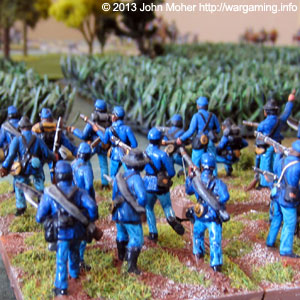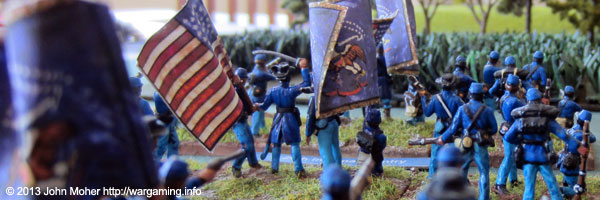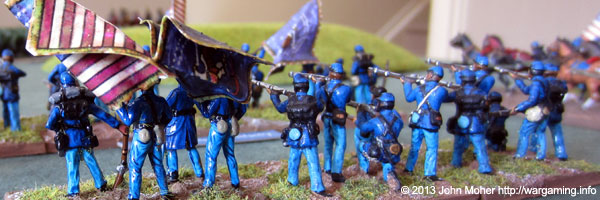After our breaking from winter quarters we began a march once more into Virginia, tasked with joining the balance of the army of the Potomac that had wintered in the vicinity of Fredericksburg, and was now under the command of Maj. Gen. Joseph Hooker. By late April the army was fully assembled and our new commander was preparing to launch his grand offensive, which you will of course now know dear reader culminates in the great battle of Chancellorsville, and we were to be in the vanguard. Setting forth on the last days of April we had crossed the Rappahannock and now pushed our columns forward through the wilderness and outlying Confederate Pickets, and headed South-East, towards the open farmland in the rear of General Lee’s army at Fredericksburg. Sporadic actions developed over these days but it was on the 1 May 1863 that the first serious clashes occurred, and we were involved…

We were near the centre of our advancing line when the cry went up that the Reb’s had been sighted and were advancing on us – almost immediately the first sounds of cannon and musketry were carried on the wind from our flanks, and we knew a general engagement was developing all along the line. We were just passing through some scattered farmsteads, when tall fields of new corn were interspersed amongst the woodlands and streams of the area – there was just enough time to deploy before Longman’s Brigade appeared before us. Neither side had a clear view of the other, corn & woodland separated us along with small rises of ground.
I had my veteran regiments on either flank with artillery support (the 2nd Michigan, 20th Indiana, 63rd Pennsylvania, and Battery E/1st Rhode Island Light Artillery on my left; 1st “Mighty” Massachusetts, 69th New York, 2nd New Hampshire and Battery M/2nd U.S. Light Artillery on my right), and in my centre were my 2 large fresh regiments (4th Maine & 6th New Jersey). The terrain rendered artillery of minimal use, but my batteries moved up in support to provide close range cannister fire to support the infantry, should the opportunity arise. We rapidly advanced through the fields of crops, and as we entered the woodland beyond we soon encountered the Confederates in some numbers; on my left the 2oth Indiana made contact with the 7th Virginia & 19th Mississippi, in the centre the 6th New Jersey with the 11th Virginia and the 4th Maine with the 17th Virginia. On our right the rebels had not advanced, a brigade of mostly cavalry with some artillery was observed beyond the stream in front of us.

The 20th Indiana was very roughly handled by the two rebel regiments, and was rapidly rendered hors de combat. In the centre the 11th Virginians threw back the 6th New Jersey rather roughly. The 4th Maine counter attacked and rolled over the top of the 17th Virginia who were scattered to the winds. However a rapid Confederate counter attack hit both the 63rd Pennsylvania on my left, and the 6th New Jersey in the centre, both were pushed back with casualties, exposing the still limbered battery E/1st Rhode Island Light Artillery. (At this time casualties favoured the Confederates 3 to 6).
The 2nd Michigan came up to support the 63rd Pennsylvania and together they put the 19th Mississippi to flight with a glorious bayonet charge, while the 4th Maine pressed through the woodland and fell upon the 4th Alabama, who were also likewise rapidly put to flight. (Casualties now favoured the Union 11 to 6).

At this point General Longman appeared to lose heart for this battle and rapidly disengaged, his forces rapidly departing from whence they had come, and our first day’s combat at Chancellorsville was effectively over – it had lasted perhaps an hour…
After the action a roll call of my division returned this:
- 1st “Mighty” Massachusetts Infantry Regiment (Strength 3; Veteran)
- 2nd Michigan Infantry Regiment (Strength 3; Veteran)
- 69th New York Infantry Regiment (Strength 5; Veteran)
- 20th Indiana Infantry Regiment – dispersed, attempting to reform
- 63rd Pennsylvania Infantry Regiment (Strength 2; Veteran)
- 2nd New Hampshire Infantry Regiment (Strength 4; Veteran)
- 6th New Jersey Infantry Regiment (Strength 4)
- 4th Maine Infantry Regiment (Strength 10)
- Battery M, 2nd US Artillery (2 x Rifles)
- Battery E, 1st Rhode Island Artillery (2 x Napoleons)
- Victory Points Earned: 5
Brigadier General A.P.S. Longman’s division retired in the following state:
- 1st Virginia Volunteer Infantry Regiment (Strength 3)
- 7th Virginia Volunteer Infantry Regiment (Strength 4; Veteran)
- 11th Virginia Volunteer Infantry Regiment (Strength 5; Veteran; Hero)
- 17th Virginia Volunteer Infantry Regiment – dispersed, attempting to reform
- 10th Alabama Volunteer Infantry Regiment – dispersed, attempting to reform
- 19th Mississippi Volunteer Infantry Regiment – dispersed, attempting to reform
- 2nd Virginia “Lynchburg Cougars” Cavalry (Strength 5)
- 4th Virginia Cavalry Regiment (Strength 8)
- “Loudon” Artillery Battery (1 x Rifle)
- Victory Points Earned: 4
The Chancellorsville battle continued for some 7 days, which you will likely know well my readers, and we were intermittently engaged, however this was our heaviest engagement of the week – and following the failure of the turning movement we retired back across the U.S. Ford on the Rappahannock, to reform on the Northern Bank whence we had come 2 weeks prior…












good news for the union finally 🙂
How come the rebs split their forces, to me they asked for the bloody nose. Was that a mechanic of the game?
cheers
Indeed – still didn’t get a lot of VPs though! 🙁
Cam’s deployment was his choice – he could have deployed all one side of the creek or the other – the creek was not a major obstacle like the prior river crossing battle either (so could be forded at a small inconvenience by Inf & Cav) – so the CSA could have advanced happily on that flank. In fact I suspect Cam was just ‘hiding’ his cavalry there (as he had 2 Regiments to my 0 and they aren’t overly useful in close terrain) and he had the little 1st Virginia & his sole gun there just to prevent me sweeping over the creek unopposed if I had chosen to (Mtd Cav doesn’t make much of dent frontally vs. Inf unless it has huge numbers)…